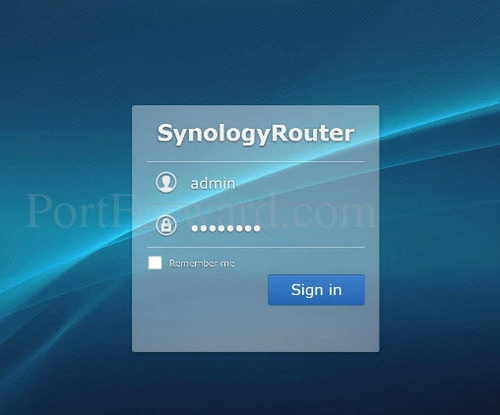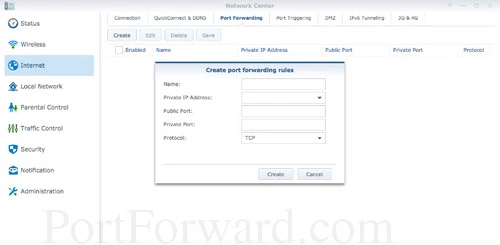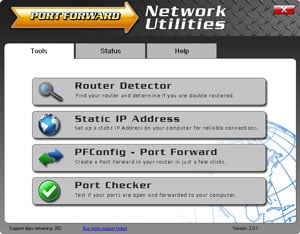Your Synology RT1900ac router has a basic firewall that helps to protect your home network from unwanted Internet access both to and from the Internet. Your firewall does this by blocking ports except a few in order for you to use the Internet. When you need additional ports opened for a game or program this is called a port forward because you are forwarding a port through the firewall to a device on your network.
In this guide we will walk you through each step in the process of port forwarding. These include:
- How to setup a static IP address on the exact device you plan on forwarding these ports to.
- How to login to the Synology RT1900ac router.
- How to find the port forwarding section of your router.
- Finally, we will be showing you what information to enter in your router to get your ports forwarded.
We think that forwarding a port should be easy. That's why we created Network Utilities. Our software does everything that you need to forward a port.
When you use Network Utilities you get your port forwarded right now!
Step 1
It is important to setup a static ip address in the device that you are forwarding a port to. This ensures that your ports will remain open even after your device reboots.
- Recommended - Our free Static IP Setter will set up a static IP address for you.
- Another way to get a permanent IP address is to set up a DHCP reservation.
- Or, manually create a static ip address with our Static IP Guides.
This step is important because you want a permanent IP address in your device. If you do not set up a permanent IP address in your device, then when you device reboots it may get a new IP address.
Use a VPN Instead
Have you considered using a VPN instead of forwarding a port? For most users, a VPN is a much simpler and more secure choice than forwarding a port.

We use and recommend NordVPN because not only is it the fastest VPN, it includes a new feature called Meshnet that makes forwarding a port no longer necessary for most applications. With NordVPN Meshnet, you can connect to your devices from anywhere in the world, completely secure, over a highly encrypted VPN tunnel.
Every time you click on one of our affiliate links, such as NordVPN, we get a little kickback for introducing you to the service. Think of us as your VPN wingman.
Step 2
When you want to login to the Synology RT1900ac router you need know that a router like this uses a web interface. This means you need to use a web browser to get into the router settings. It shouldn't matter which browser you decide to use, simply pick your favorite. Some common web browser options are: Chrome, Internet Explorer, Edge, and Firefox.
Once you have picked the web browser you want to use, open it up and find the address bar. This is normally at the top of the page like this:

Above is an example of what a web browser address bar looks like. Find the address bar in your router and type in your router's IP address.
The default Synology RT1900ac IP Address is: 192.168.1.1
Now that you have entered the router's IP address into the address bar, click the Enter key on your keyboard. If everything went according to plan you should see the following screen:

On this login screen you need to enter a username and password. According to my research you set a password during the initial setup of the Synology RT1900ac router. There is no default username and password for this device.
Having Trouble?
Hopefully you wrote down the username and password you created during the initial router setup. If you did not, there are still some things you can try:
- Our first recommendation is to try and crack your own router password. What are some common password choices you tend to use? If you want some brute force behind your guessing you can use our Find Password App. It automates the process of trying thousands of different username/password combinations to get your router accessible to you. Learn all about this helpful app on our Router Password Cracker page.
- If trying to guess your password did not work it might be time to consider a reset. The manual for the Synology RT1900ac router calls it a soft reset. A reset like this will erase not only your username and password but will erase other settings such as the firewall , DHCP services, Wi-Fi, Parental Control, and Traffic Control. To do this you press and hold the reset button on the bottom of the router for about 4 seconds. We strongly suggest trying other methods first before deciding to reset this device. For more information on resetting a router check out this How to Reset a Router page.
Step 3
After you have finished logging into the Synology RT1900ac router you need to find the port forwarding section of the menu. To do this we begin on the Home page:

Click the file labeled Network Center. In the screenshot above it is near the upper left corner.

To get to the page you see above, you need to:
- Click the Internet option in the left sidebar.
- Then choose the option at the top of the page labeled Port Forwarding
- A new sub-menu appears, pick the option of Create
Step 4
Here are the ports to forward for Xbox Live:
- TCP Ports: 3074
- UDP Ports: 3074
If you are looking for the ports for a different application you can find it by either:
- Browsing our List of Games
- Check out our our List of Games by Genre
- See our List of all Applications
Don't forget to sign up for NordVPN's promo deal before it's gone.

You might notice that most of our site doesn't have ads on it. This is because we use partnerships with companies like NordVPN to keep the site running. Thank you for supporting us by using our referral links.
Put a name for this forward in the Name box so that you can remember why you set this forward up. The name does not matter so pick something that has meaning to you.
Enter the IP address of the device that you want to forward ports to into the Private IP Address box. This can be either the IP address of your computer or the IP address of another device on your network.
Enter the port to forward into the Public Port and the Private Port boxes.
The protocol that you want to forward is selected from the Protocol box.
When you are finished, click the Create button.
Don't forget to click the Create button after you complete each port forward entry.
When you are completely finished, click the option near the top of the page labeled Save.
Test Your Ports
It is a great idea to test the ports you just forwarded. In order to do this we recommend using our Open Port Checker. This is part of our FREE trial version of the Network Utilities. Our Open Port Checker is a great tool that uses a local application to see if your ports are listening or not.
Additional Information...
For walkthroughs, port numbers, networking guides, firewall guides, or software guides check out our list here.
Need to know how to setup your router's WiFi, DNS, change the IP address, or need your router's manual, check out our sister site setuprouter.com









